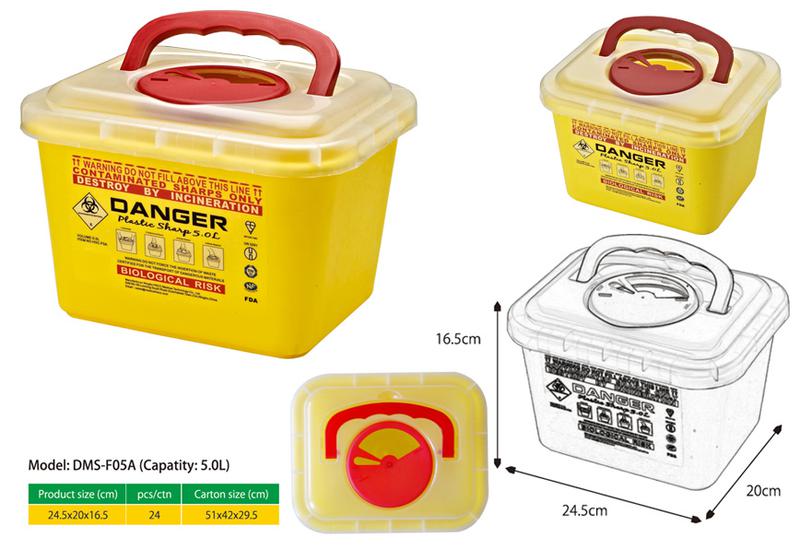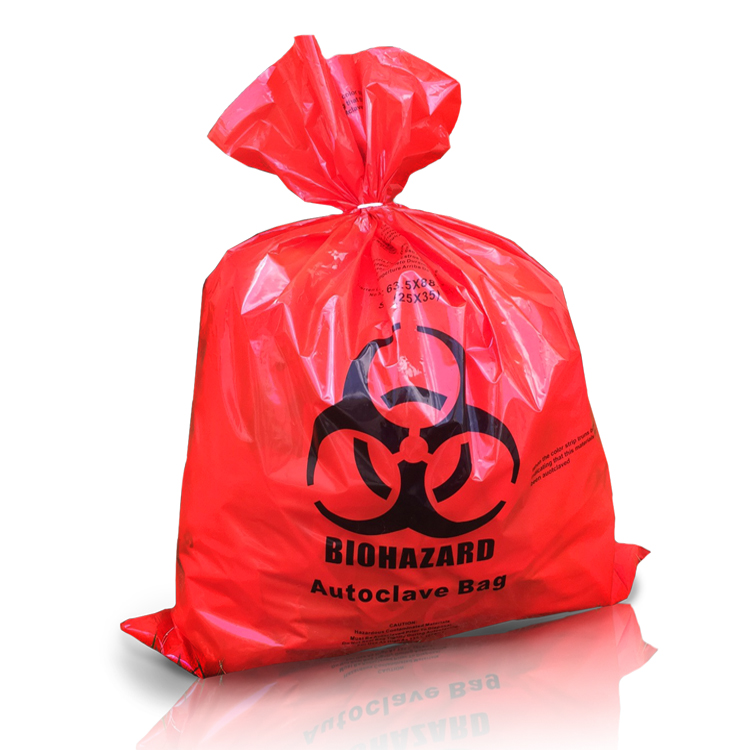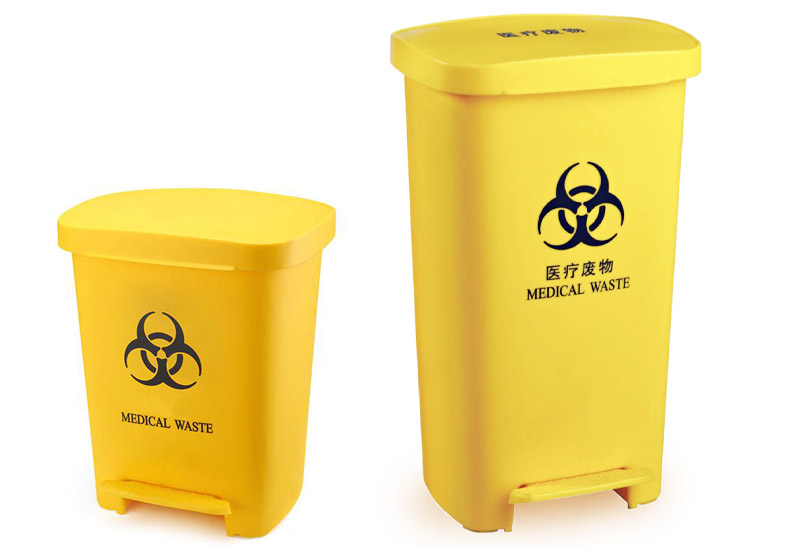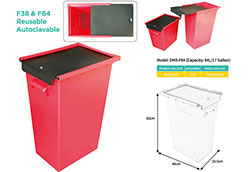Infusion waste disposal Robot is on duty in the infusion room of Shanghai Hospital! Nurse at Tongren Hospital used to bend over 800 times a day and now liberated
How hard are the nurses in the infusion room? Bent over 800 times a day!
On November 22nd, 'Big White' was quietly working in the emergency infusion room of Tongren Hospital.
I saw the nurse hung the infusion bag after pulling out the needle from the patient into its "mouth". After about 3 seconds, it had automatically cut off the infusion needle from the infusion tube and pulled it out of the infusion bag to complete The decomposition, sorting and recycling of the infusion bag.
'We have more than 300 patients who come for infusion at the peak every day, and each patient has at least two bags. According to our operating specifications, each patient's infusion bag must be treated for medical waste, and the tube must be cut off first. Then pull out the needle, put it into the sharps box, and put the bag and the tube into different categories. The whole process is cumbersome and mechanized.' said Zhou Lijin, the head nurse of the emergency infusion room of Tongren Hospital. The patient's infusion waste may need to bend down 4 times, 'roughly 800 times a day!'
Compared with tedious and repetitive work, nurses are more worried about the hidden danger of stab wounds in the process of needle removal. Needlestick injuries are a relatively common occupational infection risk for nurses. Once a needlestick injury is encountered, although emergency preventive treatment can be done immediately, it may still cause a shadow on the nurse's psychology.
Traditional Infusion waste disposal requires nurses to complete it personally, which is cumbersome and risky.
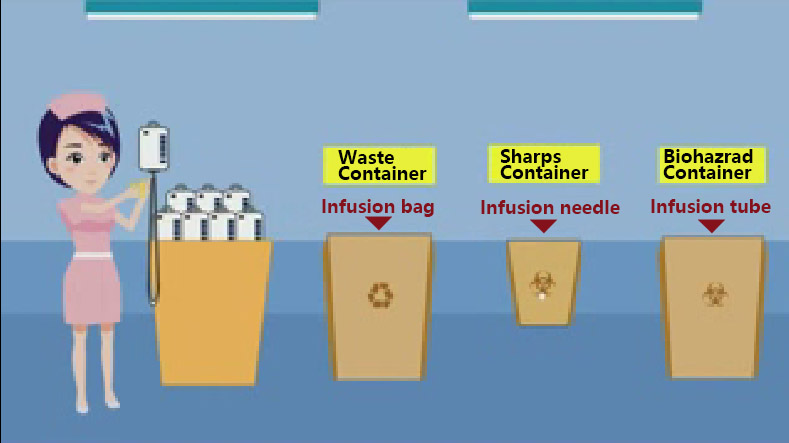
In the past few days, citizens who have gone to Shanghai Tongren Hospital to hang water will find that a'new employee' has arrived in the infusion room: a 'white and fat' robot. This is the country's first infusion medical waste sorting robot.
Since this'Dabai' sat in the infusion room, he has "eaten" all the discarded needles, bottles, and bags after the patient's infusion. Because of its arrival, the work efficiency of the nurses in the infusion room has been greatly improved, so they have more time to patrol and serve patients.
Automatic decomposition in the whole process, zero intensity, zero infection
Disposal of infusion medical waste is an indispensable procedure! In order to prevent the used infusion equipment from flowing into illegal channels, the nurse must destroy and classify the infusion medical waste at the first time, and finally send it to the medical waste recycling station for harmless treatment.
Medical waste needs timely and standardized disposal, but the working environment of frontline nurses also needs care. How to resolve this contradiction?
Starting from April 2021, Ma Jun, Dean of Tongren Hospital, and the Department of Nursing have jointly conducted innovative development with Dailymag Environmental Technology (Ningbo) Limited. It took more than 6 months to jointly develop this infusion medical waste sorting robot.
According to Sheng Huiming, deputy dean of Tongren Hospital, this robot can replace nurses to automatically complete the treatment and sorting of infusion medical waste, ease the labor intensity of nurses, and eliminate the risk of injury to hands and infection.
First of all, its size is not large, roughly equivalent to the space occupied by two trash cans.
Secondly, the 'white and fat' is easy to install, plug and use, the processing process is fully automatic, and the daily maintenance is simple. It only needs to replace the sharps box and garbage bag once a day.
In addition, the setting of the safety lock also makes the management of medical waste more secure. It is suitable for infusion rooms, day chemotherapy rooms, inpatient wards, and various places with infusion scenes, including endoscopy centers.
Since the infusion medical waste sorting robot was put on duty, the working time of nurses handling infusion medical waste has been greatly shortened from 30 seconds per time to 3 seconds per time. This not only avoids the nurse's repeated processing actions of bending over, but also from the source. The above reduces the risk of hospital feeling caused by infusion sharps.
Calculated based on the daily average infusion workload of 300 people, an average of 2.25 hours of work per day can be saved, and more time for nurses can be returned to patients.
The head nurse Zhou Lijin said that for the purpose of disposing of the infusion and medical waste, the itinerant nurses were specially arranged to take charge of this work. Now with robots, nurses have freed their hands, and more time and energy can be used to serve patients with infusions.
It is reported that the robot is innovative research and development, with originality, and has been declared for invention/utility model patents. Shanghai Tongren Hospital is also the first hospital in the country to use infusion medical waste automatic treatment equipment. It not only fundamentally protects nurses from occupational injuries, but is also improving the number of treatment infusion sets, remote monitoring of working status, and multiple in the park. Information design such as networking has also realized the closed-loop management of the entire process of infusion medical waste.
The infusion medical waste sorting robot have 1 sharps container, 1 biohazard contaner and 1 waste contianer, it can recognize and cut Infusion needle, tube and bag automaticly and dispose to the releated container.
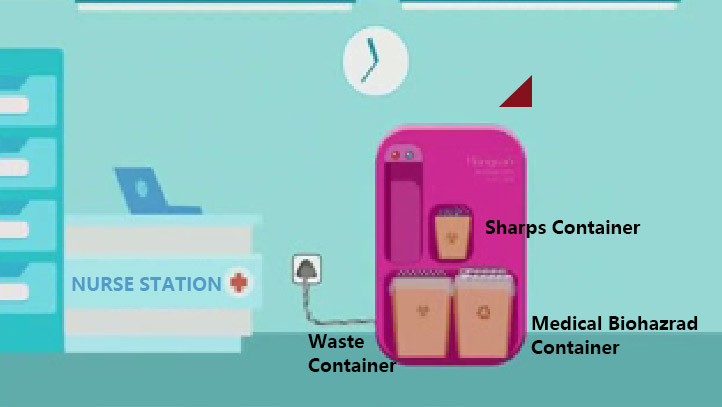
The infusion medical waste sorting robot is equipped with an ultraviolet lamp, which kills viruses 24 hours a day. When one of the three containers inside is full, the machine will automatically alarm. The hospital worker will recognize the container that needs to be replaced after seeing the machine alarm indicator, open the machine, replace the sharps container, or replace the garbage bag inside biohazard contaner or waster container.
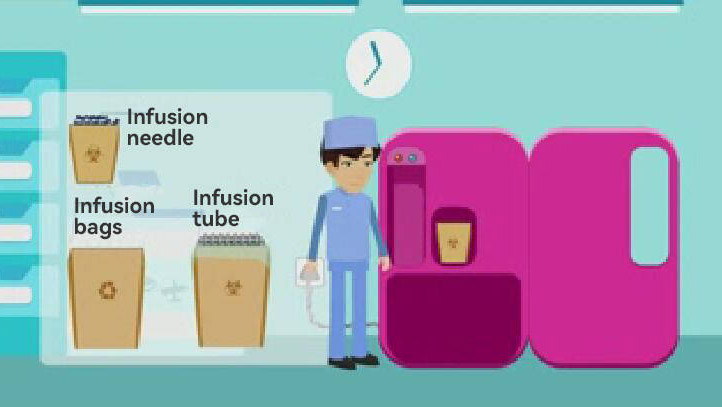
Can robots replace nurses? Not a replacement, but a collaboration
At present, with the accelerated advancement of AI intelligent technology in the medical field, some traditional labor-intensive and repetitive medical services have a trend of "machines instead of labor".
Shanghai Hongtan Biotechnology Co., Ltd. is a joint developer of infusion medical waste sorting robots. The chairman of the company Zhu Bin said that the replacement of repetitive and tedious labor with machines is indeed a major trend in the development of smart medical care in the future.
'Especially in some risky jobs that are not suitable for humans, the emergence of robots not only liberates labor, but also greatly reduces labor risks.' He said, like infusion medical waste sorting robots, it can already achieve zero intensity. Labor, zero risk of infection. In the next step, with regard to the country’s latest hospital-induction prevention and control standards, the robots will also be iteratively upgraded to meet the design and requirements of the new national standard.
Will the emergence of robots make some traditional medical service jobs disappear?
In this regard, Zhu Bin’s attitude is very clear: “In fact, this is not a replacement, but a kind of human-machine collaboration. It is actually to help our medical staff stay away from danger, make work more efficient, and make work a pleasant one. Enjoy, not completely replace.'
How to make AI intelligence better serve medical staff and reduce the occupational risks of medical jobs? Sheng Huiming, vice president of Tongren Hospital, said that in the next step, they plan to introduce robots in the nucleic acid testing laboratory.
According to reports, the current sampling process for nucleic acid samples after entering the laboratory includes: sample receipt, collection, extraction, sample mixing, machine and results, and analysis. The first four processes are solidified and mechanically homogenized, and are highly repeatable, and can be undertaken by AI robots, ensuring uniformity and high throughput, ensuring high quality, and also significantly reducing the risk of infection caused by medical staff contacting samples Probability.
In terms of CT reading, robots can be used to realize the preliminary classification of readings. Sheng Huiming said that from the perspective of big data, usually more than 30-40% of the imaging results of the film belong to the normal category. After the robot is screened, the problematic film can be screened out. In the case of insufficient imaging doctors, it can be Helping doctors specialize in reading film of difficult and difficult diseases, which will help greatly improve the efficiency of medical services. In the early stage of the COVID-19 epidemic, Tongren Hospital used AI to read images to assist in diagnosis.
'Through deep learning, robots can fully learn from the strengths of others. From a large amount of clinical data, including digital, morphological and image information, they are "trained" to become more objective, smart and diligent medical staff's partners and assistants. At present, there is a shortage of medical staff. Under the circumstances of high work intensity and high work requirements, it can indeed reduce the medical pressure and improve the patient's sense of obtaining medical treatment.'Sheng Huiming said.

